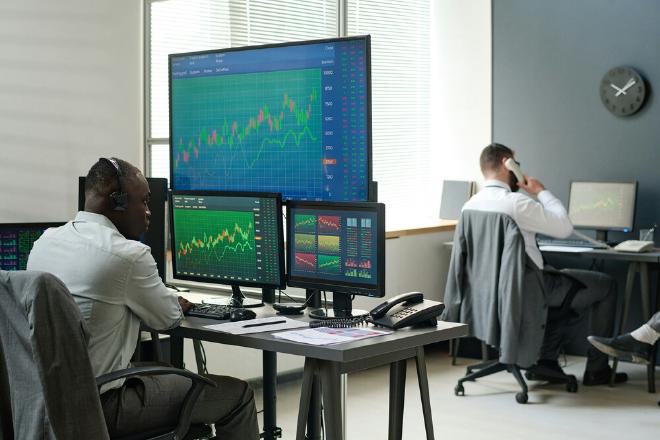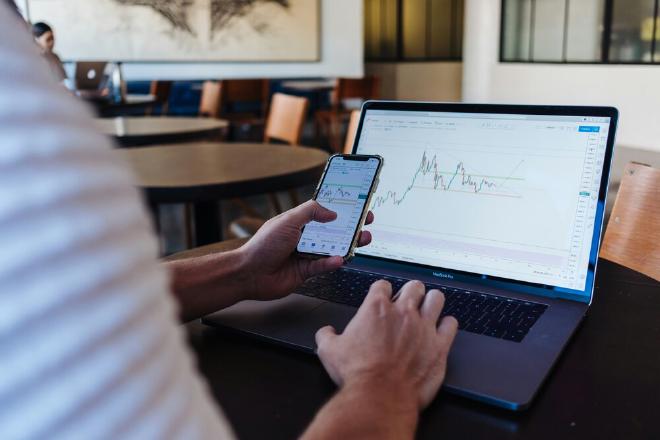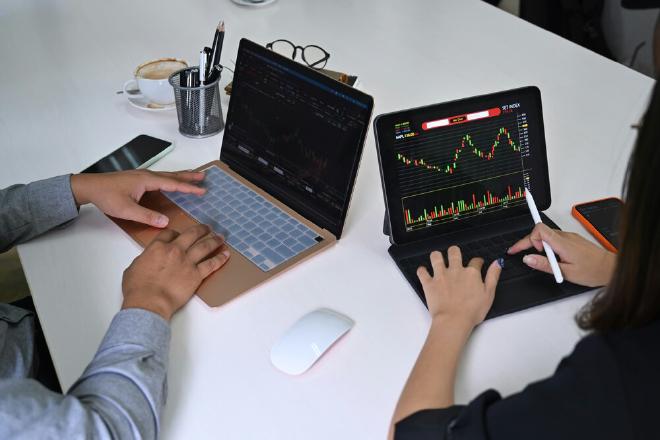Types of Trading: A Beginner's Guide to Trading Strategies

Table of Contents
When I tell people I’m into quantitative trading, I get one of two reactions:
- A blank stare followed by “Is that like Bitcoin?”
- Immediate concern that I’ve joined some sort of financial cult
Neither is accurate (well, maybe the cult part is debatable), but it highlights a larger issue—most people have no idea about the different approaches to trading, let alone which one might actually suit their personality, lifestyle, and goals.
This article is the first in a comprehensive series on swing trading for programmers.
Today we’ll cover the types of trading strategies and how to find that sweet spot between “staring at charts 14 hours a day” and “checking your portfolio once a decade when you remember your Vanguard password.”
Let’s be clear about what this article series is not:
- It’s not about getting rich quick (if something sounds too good to be true, it typically is)
- It’s not about promoting some “foolproof system” that works in all market conditions (such things don’t exist)
- It’s not financial advice (my lawyer would like me to emphasize this repeatedly)
What this series is: an honest exploration of different trading approaches, so you can figure out which one might actually work with your personality, lifestyle, and goals.
In the rest of this article, you’ll learn about:
- High-Frequency Trading (HFT)
- Day trading
- Swing trading
- Position trading
- Value investing
Trading vs. investing (they aren’t even the same sport) #

Picture two athletes: a sprinter and a marathon runner.
They’re both moving forward on their feet, but the similarities pretty much end there. Their training, mindset, and approach are completely different.
The same is true in trading versus investing.
Traders typically wear many hats—technical analyst, risk manager, psychologist, and decision-maker all rolled into one. They must process information quickly, act decisively, and manage emotions under pressure.
In contrast, investors wear the hat of a business owner, patiently assessing long-term value and focusing on fundamentals rather than short-term price fluctuations.
The philosophical gap between trading and investing #
Trading focuses on capturing short-term price movements. Traders think along the lines of:
I believe this asset will move X% in Y direction over Z timeframe, and I want to profit from that specific move.
Investing focuses on long-term value accumulation. Investors think:
I believe this asset will be worth substantially more in the future because of its fundamental characteristics.
Time horizons for investing vs. trading #
Traders measure holding periods in:
- Minutes (scalping)
- Hours (day trading)
- Days to weeks (swing trading)
- Weeks to months (position trading)
Investors think in:
- Years
- Decades
- “I’ll give these shares to my grandchildren”
Psychological challenges and mindsets #
As a trader, you’re actively making decisions—often many times per day.
You’re processing new information constantly and adjusting accordingly.
Your psychological makeup needs to handle being wrong frequently while maintaining the discipline to follow your rules.
As an investor, you need the patience of a geological formation.
Market crashes?
“That’s nice, I’ll buy more.”
Stock drops 30%?
“Interesting, let me review the business fundamentals to see if anything has actually changed.”
The trader’s mindset is tactical; the investor’s mindset is strategic.
Managing your risk exposure #
Traders typically:
- Use tight stop losses (often 1-3% from entry)
- Employ strict position sizing (risking 0.5-2% of their entire portfolio per trade)
- Have explicit exit strategies for both profit and loss
- Actively manage open positions
- Care deeply about correlation between positions
Investors typically:
- May not use explicit stop losses
- Focus on portfolio-level diversification
- Might “average down” when prices fall
- Often let winners run for years or decades
- Care more about sector and asset class diversification
Tools of the trade #
Traders primarily rely on:
- Technical analysis (charts, patterns, indicators)
- Price action
- Market internals and breadth
- Volume and order flow
- Market sentiment indicators
Investors primarily focus on:
- Fundamental analysis (financial statements, business models)
- Competitive advantages
- Management quality
- Industry trends
- Macroeconomic factors
Now, let’s explore the spectrum of trading approaches, from the fastest to the slowest.
High-Frequency Trading (HFT): Where humans need not apply #

High-frequency trading exists in a realm where seconds might as well be years, and the participants are not humans but highly specialized algorithms running on machines that cost more than most people’s houses.
What actually is HFT? #
HFT involves executing thousands or even millions of orders per day, with holding periods often measured in seconds or less.
We’re talking about capturing price movements so small that most retail traders wouldn’t even notice them on a chart.
Who does HFT? #
Primarily:
- Specialized proprietary trading firms (like Citadel Securities, Virtu, Jump Trading)
- Quant hedge funds (like Renaissance Technologies)
- Bank trading desks with serious technology investments
What you need to participate:
- Server co-location at exchanges (costing millions annually)
- Custom hardware (often FPGAs and specialized processors)
- PhD-level quants and developers
- Direct market data feeds (extremely expensive)
- Sophisticated risk management systems
Common HFT strategies #
Market making: Providing liquidity by constantly quoting both buy and sell prices, profiting from the spread.
Statistical arbitrage: Exploiting tiny price discrepancies between related securities, often holding for just seconds.
Latency arbitrage: Capitalizing on the speed advantage to act on information microseconds before others can.
The never-ending arms race #
The HFT world is defined by an arms race where firms compete to be faster by:
- Building microwave towers for straighter signal paths than fiber optic cables (seriously, that has happened)
- Developing custom chips just to shave off nanoseconds
- Paying millions for slightly better locations within exchange data centers
Risk/Reward profile #
Potential returns: Incredibly consistent when it works.
Risks:
- Catastrophic technical failures (like Knight Capital’s $440 million loss in 45 minutes)
- Rapidly diminishing edge/alpha as strategies become more crowded
- Enormous fixed costs regardless of performance
- Regulatory changes that can eliminate entire strategies overnight
For the average person reading this: This is not for you. Or me, for that matter. I’d rather try to build a rocket to Mars in my backyard—the barriers to entry would actually be lower.
Day Trading: The psychological gauntlet #

Day trading—where positions are opened and closed within the same trading day—has been democratized by technology but remains one of the most psychologically demanding approaches to markets.
The day trader’s world #
- Trading session begins and ends with zero open positions
- Typical holding periods: minutes to hours
- Usually focuses on a small set of liquid securities
- Requires constant attention during market hours
- Success depends heavily on quick decision-making and disciplined execution
Common day trading strategies #
Scalping: Making many quick trades to capture small price movements, often using level 2 data and time and sales information to identify short-term supply/demand imbalances.
Momentum trading: Identifying stocks with strong intraday momentum (often due to news or earnings) and riding the trend until it shows signs of exhaustion.
Reversal trading: Looking for overextended moves and betting on a reversion to the mean, often at key technical levels.
Gap trading: Capitalizing on overnight price gaps by predicting whether they will fill or continue in the direction of the gap.
Technical requirements for day trading #
- Real-time data feeds (not delayed)
- Level 2 market depth information
- Time and sales data
- Multiple monitors
- Low-latency connection
- Specialized trading software
- News feeds
The psychological reality of day trading #
Day trading is to your mind what CrossFit is to your body—intense, demanding, and not for everyone.
You’ll need:
- The ability to make quick decisions without complete information
- Emotional discipline to cut losses immediately
- Mental stamina to maintain focus for 6+ hours
- Capacity to handle being wrong multiple times daily
- Resistance to the dopamine rush of winning (which can lead to overtrading)
Studies consistently show that 80-95% of retail day traders lose money.
This isn’t because day trading can’t work—it’s because the psychological demands exceed what most people can handle.
The Real Risk/Reward #
Potential returns: Significant—successful day traders can generate 5-20% monthly returns.
Realistic drawbacks:
- Extremely high failure rate for beginners
- Requires full-time commitment
- Performance highly variable from month to month
- Significant stress and potential health impacts (not uncommon for day traders to develop severe gastrointestinal issues)
- The Pattern Day Trader (PDT) rule requires $25,000 minimum account (US markets) (source)
Who this suits:
- People with exceptional emotional discipline
- Those who can think probabilistically under pressure
- Individuals who don’t mind sitting at a computer all day
- Someone comfortable with high-stress environments
- People who enjoy intense focus
If you’ve ever thrown your phone because an app took 3 seconds to load (not that I have ever done that), day trading might not be your calling.
Swing Trading: The Goldilocks zone (and my personal preference) #

Swing trading is where I’ve personally found my sweet spot in the markets.
It’s the “not too hot, not too cold” approach that balances meaningful price movements with a manageable lifestyle.
What makes it “swing” trading? #
Swing trading involves capturing “swings” in price that typically play out over:
- 2-5 days on the shorter end
- 2-3 weeks on the longer end
You’re looking to capture more significant moves than day traders (often 5-20% rather than 0.5-2%), which means you can be more selective about your entries and don’t need to be glued to your screens all day.
Why I gravitate towards swing trading? #
After experimenting with various trading styles, swing trading clicked for me because it:
- Allows for deeper analysis before entry: I can take my time analyzing setups, running my Python screening tools, and planning trades in advance.
- Permits work-life balance: I don’t need to watch the market all day—just morning analysis, maybe a midday check, and end-of-day review.
- Leverages both technical and fundamental catalysts: I can incorporate both chart patterns and fundamental events like earnings or product launches.
- Suits my psychological makeup: I find day trading too frantic and investing too passive—swing trading provides just enough action without overwhelming me.
- Works beautifully with automation: Many swing trading setups can be systematically identified using Python, allowing me to scan the entire market efficiently.
Key swing trading strategies #
Trend following: Identifying securities in established trends and entering on pullbacks or consolidations.
Breakout trading: Looking for stocks breaking out of ranges or technical patterns with increased volume.
Mean reversion: Identifying oversold or overbought conditions and betting on a reversion to the mean.
Catalyst-driven swings: Entering positions ahead of known events (earnings, product releases, etc.) or right after news causes a significant repricing.
Technical tools swing traders love #
- Moving averages (particularly the daily 20 EMA, 50 SMA, and 200 SMA)
- Relative Strength Index (RSI) for overbought/oversold conditions
- Support and resistance levels (including Fibonacci retracements)
- Volume analysis
- Chart patterns (flags, cup and handle, head and shoulders)
The risk/reward profile of swing trading #
Potential returns: Successful swing traders typically target 20-50% annual returns.
Risk considerations:
- Overnight exposure (subject to gap risk where price gaps up or down unexpectedly)
- Requires enough capital to withstand normal volatility
- Less frequent trade opportunities than day trading
- Still requires regular market monitoring
- Can face stretches of unfavorable market conditions (sometimes months to years)
Who this suits:
- People with day jobs who can’t watch markets constantly
- Those who prefer deeper analysis over split-second decisions
- Individuals who want active participation without overwhelming stress
- Traders with moderate risk tolerance
- Programmers who enjoy building market scanning systems
Position Trading: The extended stay #

Position trading occupies the land between active trading and passive investing. It involves holding positions for months to years, but with more active management than buy-and-hold investing.
The position trader’s approach #
Position traders identify significant, long-term moves and aim to capture the meat of the trend, typically holding for:
- Several months on the shorter end
- 1-2 years on the longer end
They’re less concerned with daily noise and more focused on major trend changes and fundamental shifts.
Identifying position trading opportunities #
Position traders often blend:
- Long-term technical analysis (weekly and monthly charts)
- Fundamental trends (growing industries, changing consumer behaviors)
- Macroeconomic factors (interest rates, economic cycles)
- Secular trends (technological shifts, demographic changes)
They’re looking for substantial directional moves—think “the rise of generative AI” rather than “this stock is oversold on the daily chart.”
The psychological advantage #
Position trading offers a significant psychological benefit: you don’t need to worry about daily market noise.
This approach allows for:
- Less frequent decision-making
- Reduced emotional reactions to market movements
- More time for thorough analysis
- Better work-life balance
- Lower commission costs
Risk management for position traders #
Position traders typically use:
- Wider stop losses (often 15-25% from entry)
- Smaller position sizes than shorter-term traders
- Trailing stops that lock in profits as trends develop
- Portfolio-level diversification across multiple positions
- Partial profit-taking at significant levels
Who thrives as a position trader? #
- Professionals with demanding careers who can’t monitor markets daily
- Patient individuals who don’t need constant action
- People with larger portfolios who can afford wider stops
- Those who enjoy significantly deeper research and fundamental analysis
- Traders who want to capture significant market moves without the stress of shorter timeframes
Value Investing: The Warren Buffett approach #

Value investing isn’t trading at all—it’s buying ownership stakes in real businesses, not just trading ticker symbols—with a focus on long-term value creation rather than price movements.
The value investor’s philosophy #
Value investors believe:
- Markets are often inefficient in the short term but efficient in the long term
- Stocks represent ownership in actual businesses, not just tickers on a screen
- The key to success is buying at a significant discount to intrinsic value
- Patience is rewarded more than quick decision-making
- Temperament matters more than IQ
Key metrics value investors examine #
- Price-to-earnings ratio (P/E)
- Price-to-book value (P/B)
- Debt-to-equity ratio
- Free cash flow yield
- Return on invested capital (ROIC)
- Dividend yield and history
- Competitive moats and advantages
The time horizon of value investing #
Value investing requires extreme patience:
- Typical holding periods of 5-10 years or longer
- Willingness to hold through significant drawdowns
- Focus on business results, not stock prices
- Quarterly statements matter more than daily price action
- Success measured over decades, not years
“Margin of safety” approach to risk #
Rather than using stop losses, value investors protect themselves by:
- Only buying at a significant discount to estimated intrinsic value (30-50%)
- Diversifying across industries and business types
- Focusing on companies with strong balance sheets
- Avoiding businesses they don’t understand
- Being willing to hold cash when opportunities don’t exist
Who thrives as a value investor? #
- People with exceptional patience
- Those who enjoy financial statement analysis
- Individuals who can think independently of market sentiment
- People with long time horizons (10+ years)
- Those who don’t need the excitement of frequent trading
Why I’m a swing trader (and whether you should be too) #
After experimenting with various approaches over the past few years, I’ve found that swing trading provides the optimal balance for my situation, personality, and goals.
The time commitment makes sense to me #
Day trading would require me to stare at screens for 6+ hours daily, abandoning my other projects and probably my sanity.
Swing trading lets me conduct analysis in the evenings, place orders before the market opens, check progress once or twice during the day, and review positions at the close.
Total time commitment: 1-2 hours daily, with most of the work being intellectually stimulating analysis rather than stressful real-time decision-making.
The risk/reward profile fits my goals #
In the long run, I’m targeting 25-40% annual returns (obviously with no guarantee I’ll achieve this), which swing trading can potentially deliver while still allowing for:
- Defined risk management
- Diversification across multiple positions
- The ability to be selective about entries
- Enough trades to build statistical significance
- Risk parameters that let me sleep at night
I like to sleep easy at night #
I’ve discovered that nothing ruins your psychological edge faster than lost sleep.
With swing trading:
- Positions are sized so that gap risk doesn’t keep me up at night
- Stop losses are placed at logical technical levels, not arbitrary percentages
- I never have more than 15-20% of my portfolio at risk at once
- I can take days off without constantly checking my phone
Python automation supercharges my swing trading #
My background in computer vision and machine learning gives me an edge in building automated systems that:
- Scan thousands of stocks daily for specific technical patterns
- Calculate optimal position sizes and stop levels
- Track correlations between positions
- Identify sector rotations and market regime changes
- Backtest strategies across various market conditions
This marriage of programming and trading is why PythonFinTech exists—to share how Python can be applied to finding and managing swing trades.
Stress management is the hidden edge #
I’ve found my trading performance is inversely proportional to my stress level.
Swing trading hits the sweet spot:
- Not so slow that I get bored and make impulsive trades
- Not so fast that I make stress-induced errors
- Active enough to keep me engaged
- Methodical enough to rely on systems rather than emotions
Comparing trading approaches and finding your fit #

Let’s break down the key considerations to help you determine which approach might work best for you:
Time commitment required #
| Approach | Daily Time Required | Monitoring Frequency | Vacation-Friendly? |
|---|---|---|---|
| HFT | 24/7 systems monitoring | Constant | No (requires technical team) |
| Day Trading | 6-8 hours | Minute-by-minute | No |
| Swing Trading | 1-2 hours | Morning/Evening | Yes (with stop orders) |
| Position Trading | 30min - 1 hour | Daily/Weekly | Yes |
| Value Investing | 5-10 hours/month | Monthly/Quarterly | Absolutely |
Minimum practical capital #
| Approach | Minimum Capital | Optimal Capital | Notes |
|---|---|---|---|
| HFT | $10M+ | $100M+ | Institutional only |
| Day Trading | $25K (US PDT rule) | $50K-$200K | High transaction costs below minimum |
| Swing Trading | $5K-$10K | $25K-$500K | Sweet spot for retail traders |
| Position Trading | $25K | $50K-$1M+ | Wider stops require larger accounts |
| Value Investing | Can start small | Most effective at $100K+ | Compounds over decades |
Technology requirements #
| Approach | Hardware Needs | Software Needs | Data Requirements |
|---|---|---|---|
| HFT | Custom servers, FPGAs | Proprietary algorithms | Direct exchange feeds |
| Day Trading | Multiple monitors, fast PC | Specialized platforms | Real-time data, Level 2 |
| Swing Trading | Standard laptop/desktop | Charting software | Daily data, some real-time |
| Position Trading | Basic computer | Basic charting platform | EOD data sufficient |
| Value Investing | Any computer | Spreadsheets, research tools | Fundamental data, filings |
Personality fit considerations #
Here’s where honest self-assessment is crucial:
You might thrive as a day trader if:
- You make quick decisions without second-guessing
- You can follow rules with iron discipline
- You perform well under pressure
- You can admit being wrong immediately
- You don’t get emotionally attached to positions
Swing trading might be your sweet spot if:
- You enjoy analysis but also want regular action
- You can be patient enough to wait for ideal setups
- You’re comfortable with some overnight risk
- You like a balance of technical and fundamental factors
- You prefer quality trades over quantity
Position trading could suit you if:
- You have the patience to let trades develop over months
- You don’t need daily excitement from your portfolio
- You can tune out short-term market noise
- You have strong conviction in your analysis
- You prefer fewer, higher-conviction trades
Value investing might be your path if:
- You think like a business owner, not a trader
- You have exceptional patience (measured in years)
- You enjoy reading financial statements and annual reports
- You can comfortably ignore market sentiment
- You don’t need frequent validation from your portfolio
Getting started with your chosen approach to trading #
Regardless of which trading style appeals to you, here’s how to begin your journey.
Start with an honest self-assessment #
Before diving in, take inventory of…
Time: How many hours can you realistically dedicate daily/weekly?
- Day trading requires 4-8 hours of focused market time
- Swing trading needs 1-2 hours, primarily before/after market hours
- Position trading can be managed with a few hours weekly
- Value investing might need just a few days monthly for research
Capital: What’s your starting point?
- Under $10K: Focus on learning, not earning
- $10K-$25K: Swing or position trading with careful position sizing and risk management
- $25K+: All approaches available (including day trading in the US)
- Under $25K in the US: Avoid day trading due to PDT restrictions
Technical knowledge: Where are you starting from?
- Programming background: Leverage this for systematic approaches
- Finance background: Build on fundamentals while learning technicals
- Complete beginner: Start with education, paper trading, and small positions
Setting realistic first-year expectations #
Your first year should prioritize:
- Protecting your capital (aim to break even, not get rich)
- Developing and testing your process
- Building psychological resilience
- Collecting your own trading data
- Creating a trade journal that chronicles your trades, why you took them, etc.
- Monthly analysis of your trade journal so you can learn from your winners and losers
- Refining your approach based on results
If you break even your first year while building skills and preserving capital, consider it a massive success.
Final thoughts #
There’s no perfect trading approach—only the one that fits your unique combination of:
- Available time
- Starting capital
- Technical knowledge
- Psychological makeup
- Financial goals
The approach that looks most exciting may not be the one at which you’ll actually succeed.
The best trading style is the one you can consistently execute while managing risk and maintaining your mental health.
I’ve found my sweet spot in swing trading, using Python to enhance my analysis and automate the routine aspects. Whether that’s the right approach for you depends on your own situation and personality.
What I can tell you with certainty:
The most successful traders I know aren’t the ones with the most complex strategies or the quickest reflexes—they’re the ones who thoroughly understand themselves and have built a trading approach that aligns with who they are.
👉 Join my email list to be notified when the next article in this series is published.
Disclaimer: This is my trading journal, not your personal investment guide. Think of it like watching someone's cooking show — just because I'm making pad thai doesn't mean you should too (especially if you're allergic to peanuts). Sometimes I hold positions in the stocks I write about (shocking, I know). But that doesn't mean you should copy my trades and YOLO your life savings. Do your own research, consult actual professionals, and never trade more than you can afford to lose.